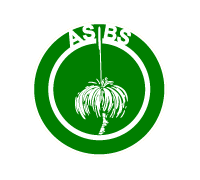
ASBS Newsletter – Book Review
Eucalyptus
written by Murray Bail.
(From ASBS Newsletter Number 97, December 1998)
Text Publishing, Melbourne, 1998.
255 pp.
Price: $29.95
No, this is not a revision of the genus but you are more likely to read it right through than such a taxonomic work. Believe it or not, Murray Bail has written a novel in which gum trees - all of them! - feature as a significant part of the story. Holland, a widower, settles with his young daughter, Ellen, on a property in western New South Wales, where he plants every known eucalypt. As Ellen grows into a beautiful woman, Holland (without consulting her) decides that the man who can name every species will win her hand. After many suitors try and fail, Mr Cave appears and steadily moves through the property, naming each species as he goes. Ellen finds him quite unappealing, but during her own wanderings comes across another man (whose reason for being there is not explained). He tells her many stories of other lands and places, then disappears. When it seems certain that Cave will win the contest, Ellen takes to her bed with a wasting illness that no-one can diagnose. Just as her case seems hopeless, the 'other man' reappears. I leave the ending to you to discover.
Murray Bail has clearly gone to some length to know eucalypts, their distribution, and how they are classified, and has woven many facts and anecdotes, not to mention some intriguing ideas, into his novel. The rediscovery of E. rameliana gets a mention. And Corymbia is there, too (even if described as a family rather than genus) in the form of C. aparrarinia - 'isn't that a marriage of the Mafia and the Aboriginal?' There is a bias against wattles here, described as 'a series of pathetic little bushes.'
Because of memories from childhood of burnt sugar, Holland planted, out of sight of the house, 'a Sugar Gum (Eucalyptus cladocalyx), when everybody knows the Sugar Gum is central to understanding eucalypts, at least visually.'
When he had difficulty naming a species, Holland had 'to send specimens of fruit and leaves to a world authority in Sydney, and seek a second opinion in other places. No one expert in eucalypts had all the answers. So pale and hypersensitive were these experts, relegated as they were to the backwaters of irrelevant institutions, they replied by return with a helpful vehemence, supplying far too much detail.' If-that is an outside view of a herbarium and its occupants we have some educating to do!
A few more quotes:
-
'Really, what sort of man could go and name all the trees? ... The sheer number of names shifting about in English and Latin would occupy vital space in a person, space that could be used for other, more natural things...'
'Idly, he looked away from the tree in question, a maddeningly nondescript mallee, obstinately modest, one barely surviving - the shrubby E. fruticosa, it's easily confused with E. foecunda.'
'... certain eucalypts pass before the eyes in such lavish quantities they undergo a sort of optical browning, and actually become invisible with ordinariness, as is the fate of weeds and telegraph poles.'
Each chapter is headed with a species name, e.g. Marginata, Racemosa, Baileyana. Sometimes its association with the content is clear, in other cases obscure. The last chapter is Confluens.
This is an eminently readable novel, yet challenging to the mind.
Reviewer: Alex George
'Four Gables',
18 Barclay Road,
Kardinya,
Western Australia 6163